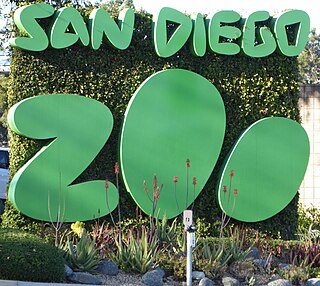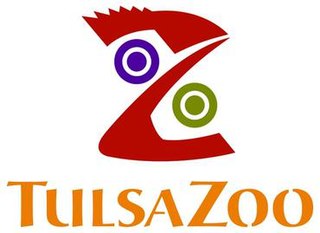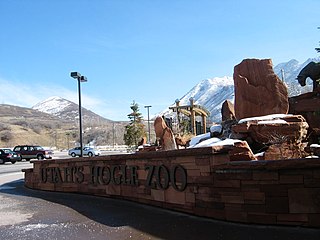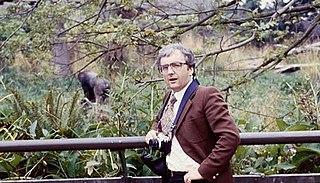
The Bronx Zoo is a zoo within Bronx Park in the Bronx, New York. It is one of the largest zoos in the United States by area and is the largest metropolitan zoo in the United States by area, comprising 265 acres (107 ha) of park lands and naturalistic habitats separated by the Bronx River. On average, the zoo has 2.15 million visitors each year as of 2009. The zoo's original permanent buildings, known as Astor Court, were designed as a series of Beaux-Arts pavilions grouped around the large circular sea lion pool. The Rainey Memorial Gates were designed by sculptor Paul Manship in 1934 and listed on the National Register of Historic Places in 1972.

The Cincinnati Zoo & Botanical Garden is the sixth oldest zoo in the United States, founded in 1873 and officially opening in 1875. It is located in the Avondale neighborhood of Cincinnati, Ohio. It originally began with 64.5 acres (26.1 ha) in the middle of the city, but has spread into the neighboring blocks and several reserves in Cincinnati's outer suburbs. It was appointed as a National Historic Landmark in 1987.

The National Zoological Park, commonly known as the National Zoo, is one of the oldest zoos in the United States. It is part of the Smithsonian Institution and does not charge admission. Founded in 1889, its mission is to "provide engaging experiences with animals and create and share knowledge to save wildlife and habitats".

The San Diego Zoo is a zoo in Balboa Park, San Diego, California, housing 4000 animals of more than 650 species and subspecies on 100 acres (40 ha) of Balboa Park leased from the City of San Diego. Its parent organization, San Diego Zoo Wildlife Alliance, is a private nonprofit conservation organization, and has one of the largest zoological membership associations in the world, with more than 250,000 member households and 130,000 child memberships, representing more than a half million people.

Woodland Park Zoo is a wildlife conservation organization and zoological garden located in the Phinney Ridge neighborhood of Seattle, Washington, United States. It is the recipient of over 65 awards across multiple categories, and had served approximately 1.4 million domestic and international visitors in 2019.

ZSL Whipsnade Zoo, formerly known as Whipsnade Wild Animal Park, is a zoo and safari park located at Whipsnade, near Dunstable in Bedfordshire, England. It is one of two zoos that are owned by the Zoological Society of London (ZSL), a charity devoted to the worldwide conservation of animals and their habitats.

The Oregon Zoo, originally the Portland Zoo and later the Washington Park Zoo, is a zoo located in Washington Park, Portland, Oregon, approximately 2 miles (3.2 km) southwest of downtown Portland. Founded in 1888, it is the oldest zoo west of the Mississippi River.

The Cleveland Metroparks Zoo aka Cleveland Zoological Park is a 183-acre (74 ha) zoo in Cleveland, Ohio. The Zoo is divided into several areas: Australian Adventure; African Savanna; Northern Wilderness Trek, The Primate, Cat & Aquatics Building, Waterfowl Lake, The RainForest, and the newly added Asian Highlands. Cleveland Metroparks Zoo has one of the largest collections of primates in North America, The Zoo is a part of the Cleveland Metroparks system.

The Los Angeles Zoo and Botanical Gardens is a 133-acre (54 ha) zoo founded in 1966 and located in Los Angeles, California. The city of Los Angeles owns the entire zoo, its land and facilities, and the animals. Animal care, grounds maintenance, construction, education, public information, and administrative staff are city employees. As of June 2019, Denise M. Verret serves as the zoo's director, the first female African American director of an Association of Zoos and Aquariums-accredited institution.

Point Defiance Zoo & Aquarium (PDZA) is the only combined zoo and aquarium in the Pacific Northwest, located in Tacoma, Washington, US, owned by Metro Parks Tacoma. Situated on 29 acres (12 ha) in Tacoma's Point Defiance Park, the zoo and aquarium are home to over 9,000 specimens representing 367 animal species. The zoo was founded in 1905; the aquarium was founded in 1935 near Commencement Bay and relocated within the zoo in 1963. Both are accredited by the Association of Zoos and Aquariums. In Pierce County, Washington, this is said to be one of the most popular tourist destinations. Bringing in over more than 600,000 visitors per year.

The Oklahoma City Zoo and Botanical Garden is a zoo and botanical garden located in Oklahoma City's Adventure District in northeast Oklahoma City, Oklahoma.

The Tulsa Zoo is an 84-acre (34 ha) non-profit zoo located in Tulsa, Oklahoma, United States. The Tulsa Zoo is owned by the City of Tulsa, but since 2010, has been privately managed by Tulsa Zoo Management, Inc. The zoo is located in Mohawk Park, one of the largest municipal parks in the United States.

Adelaide Zoo is Australia's second oldest zoo, and it is operated on a non-profit basis. It is located in the parklands just north of the city centre of Adelaide, South Australia. It is administered by the Royal Zoological Society of South Australia Incorporated, which is a full institutional member of the Zoo and Aquarium Association (ZAA) and the World Association of Zoos and Aquariums (WAZA), and which also administers the Monarto Safari Park near Murray Bridge.

The Pittsburgh Zoo & PPG Aquarium is one of only six major zoo and aquarium combinations in the United States. Located in Pittsburgh, Pennsylvania's Highland Park, the zoo sits on 77 acres (31 ha) of park land where it exhibits more than 4,000 animals representing 475 species, including 20 threatened or endangered species.

Denver Zoo is an 80-acre (32 ha) nonprofit zoological garden located in City Park of Denver, Colorado, United States. Founded in 1896, it is operated by the Denver Zoological Foundation and funded in part by the Scientific and Cultural Facilities District (SCFD) in addition to ticket sales and private donations. It is the most visited paid attraction in Colorado.

Utah's Hogle Zoo is a 42-acre (17 ha) zoo located in Salt Lake City, Utah. It houses animals from diverse ecosystems. It is located at the mouth of Emigration Canyon. Hogle is an accredited member of the Association of Zoos and Aquariums (AZA) and the World Association of Zoos and Aquariums (WAZA).
Packy was an Asian elephant at the Oregon Zoo in Portland, Oregon, United States. He was famous for having been the first elephant born in the Western Hemisphere in 44 years. At the time of his death, he was the oldest male Asian elephant in North America. With a shoulder height of 10 feet 6 inches (3.20 m) and overall height of more than 12 feet (3.7 m) when standing up straight, Packy was also one of the tallest elephants in the United States and perhaps one of the tallest worldwide.
Johnpaul Jones is an American architect and landscape architect, partner in Seattle-based architecture firm Jones & Jones Architects and Landscape Architects, best known for innovative habitat immersion method design of zoo exhibits. A Native American himself, he has also executed many projects for various Native American organizations, and was lead design consultant for the Smithsonian Institution's National Museum of the American Indian, completed 2004 in Washington, D.C. He was the first architect ever to receive the National Humanities Medal.

David Hancocks is a British architect and designer for zoos, natural history museums, botanic gardens, and nature centers. Notable for overseeing the creation of the Woodland Park Zoo's revolutionary gorilla exhibit, which for the first time utilized mature trees natural foliage merged seamlessly for both the animals and the visitors. The technique was dubbed a landscape immersion exhibit, and has become the often imitated standard for accredited zoos across the globe.
















